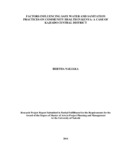| dc.description.abstract | Safe water and adequate sanitation are basic to the health of every person on the planet, yet many people throughout the world do not have access to these fundamental needs. The purpose of this study was to establish the factors Influencing safe water and sanitation practices on community health of Kajiado Central District Residents, Kenya, through the knowledge, attitude and practices survey for constructed water points. The study was conceived due to the fact that developing countries are lagging behind in meeting the set millennium goal and Kenya being one of them. The objectives of the study were to establish how water sources influences community health of Kajiado Central District Residents; to ascertain how water storage practice influence
community health of Kajiado Central District Residents and to examine water treatment and quality influence on community health of Kajiado Central District Residents. The study employed the descriptive survey method and used qualitative methods to analyze the relationships between variables and further interpretation. The target population was 400 households and the sample size 78 households. The research instrument used was a questionnaire. The analysis of data was quantitative that involved use of frequency counts and distribution, tabulation, totals and calculation of percentages. Data was analyzed using the Statistical Package for Social Sciences (SPSS Version 17.0) software whose output was presented in form of frequency and percentages. Statistical analysis was by means of means,
variance, and standard deviation with cross tabulation to draw conclusion. Majority of the
respondents (55.1%) indicated that it takes more than one hour to get water during the dry season, which shows that the area lags behind in access to safe water. The study further ascertained that majority of the population (91%) do not have access to a latrine at the household level which clearly showed that sanitation level was still very low. The hygiene behavior is quite unacceptable especially considering that 88.5% of the respondents pointed out that stool are disposed of by throwing in the field. There is therefore the need to create awareness for safe excreta disposal. These results will assist the relevant government ministry and development partners to plan, mobilize resources and implement interventions for WASH in the area. From my study, recommendations of the report include: intervention to ease access to safe water at
recommended service levels as they have to travel more than 30 minutes as the time taken to get water, need to create awareness for safe excreta disposal and hygiene education promotion within the community to create awareness for sanitation facilities at the household levels be put in place. The study concludes that promotion of community awareness on WASH so that people
understand links between diarrheal diseases; latrine use and interruption of the fecal-route of
disease transmission, and importance of hand-washing alongside provision of safe water will
improve the health of the population and put Kenya on track in attaining the millennium goals.
Suggested areas of research are in efficiency and effectiveness of health education or hygiene
promotion awareness on safe water, sanitation and hygienic practices should be studied as a preventive measure of diseases. | en_US |

